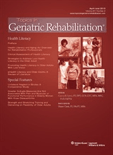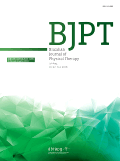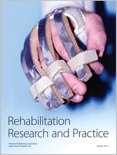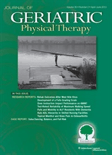
TOPICS IN GERIATRIC REHABILITATION
Scope & Guideline
Innovating Rehabilitation for Aging Populations
Introduction
Aims and Scopes
- Geriatric Rehabilitation Practices:
The journal emphasizes evidence-based rehabilitation techniques tailored for older adults, including physical therapy, occupational therapy, and innovative rehabilitation technologies. - Multidisciplinary Approaches:
It promotes interdisciplinary collaboration among healthcare professionals to optimize rehabilitation outcomes, encouraging studies that integrate services from various health disciplines. - Frailty and Functional Assessment:
A significant focus is placed on the assessment and management of frailty, advocating for tools and interventions that enhance functional independence among older adults. - Telehealth and Remote Rehabilitation:
With the rise of technology, the journal explores telehealth applications in geriatric rehabilitation, examining its effectiveness and accessibility for older populations. - Chronic Conditions Management:
Research on managing chronic conditions prevalent in older adults, such as cardiovascular diseases, arthritis, and cognitive impairments, is a core area of study. - Innovative Assessment Tools:
The journal encourages the development and validation of new assessment tools for evaluating the rehabilitation needs and outcomes in older adults.
Trending and Emerging
- Telehealth Innovations:
The rapid adoption of telehealth solutions in response to the COVID-19 pandemic has resulted in an increased emphasis on remote assessment and rehabilitation strategies for older adults. - Frailty and Comprehensive Geriatric Assessments:
There is a growing trend in research focusing on comprehensive assessments of frailty, including its impact on rehabilitation outcomes and strategies to mitigate its effects. - Artificial Intelligence in Rehabilitation:
Emerging studies are exploring the use of artificial intelligence to enhance rehabilitation practices, providing personalized interventions and improving patient outcomes. - Holistic and Multicomponent Interventions:
Research is increasingly focusing on holistic approaches that combine physical, cognitive, and psychosocial interventions to address the multifaceted needs of older adults. - Impact of COVID-19 on Rehabilitation Practices:
The ongoing effects of the COVID-19 pandemic have led to a surge in studies examining alterations in rehabilitation practices and patient outcomes during and after the crisis.
Declining or Waning
- Low Vision Rehabilitation:
Research related to low vision rehabilitation has seen a decrease in frequency, possibly due to the growing emphasis on broader rehabilitation themes and the integration of technology in care. - Traditional In-Person Rehabilitation Models:
As telehealth and remote rehabilitation gain traction, traditional in-person rehabilitation models are becoming less prevalent in the journal's publications. - Basic Mobility Interventions:
While basic mobility remains essential, there is a noticeable shift away from studies solely focused on simple mobility interventions towards more complex, multifactorial rehabilitation strategies. - Psychosocial Aspects of Rehabilitation:
Although still important, the exploration of psychosocial factors affecting rehabilitation outcomes appears less frequently, indicating a potential need for more integrated studies.
Similar Journals

Brazilian Journal of Physical Therapy
Exploring New Frontiers in RehabilitationBrazilian Journal of Physical Therapy (ISSN: 1413-3555; E-ISSN: 1809-9246), published by the ASSOCIACAO BRASILEIRA PESQUISA POS-GRADUACAO FISIOTERAPIA-ABRAPG-FT, stands at the forefront of contemporary research in physical therapy and rehabilitation. Hailing from Brasil, this esteemed journal has achieved remarkable recognition, proudly ranking in the Q1 quartile for Orthopedics and Sports Medicine, as well as Physical Therapy, Sports Therapy, and Rehabilitation, according to 2023 metrics. With a commendable Scopus ranking—positioned #10 out of 161 in Medicine Rehabilitation and #32 out of 247 in Health Professions Physical Therapy—this journal serves as a vital resource for researchers, clinicians, and students alike. It delivers cutting-edge research and innovative clinical practices, fostering advancements in treatment strategies and rehabilitation methodologies over its coverage span from 2007 to 2024. Although it operates under a traditional accessibility model, the journal's commitment to disseminating knowledge enhances the academic landscape of physical therapy and is indispensable for those dedicated to improving patient outcomes.

European Journal of Physical and Rehabilitation Medicine
Breaking Barriers: Open Access to Revolutionary Rehabilitation KnowledgeWelcome to the European Journal of Physical and Rehabilitation Medicine, the premier peer-reviewed journal focusing on advancements in the fields of physical therapy, sports therapy, and rehabilitation. Published by EDIZIONI MINERVA MEDICA, this journal has established itself as a leading resource since its inception in 2008, now enjoying an impressive Q1 ranking in these disciplines according to 2023 metrics. With an emphasis on rigorous research and innovative clinical practice, the journal facilitates the dissemination of high-quality, evidence-based studies, contributing to the enhancement of patient care and therapeutic strategies. As an Open Access platform since 2022, the journal widens its reach, enabling researchers, clinicians, and students across the globe to access valuable insights without barriers. Residing in Italy, the journal's focus transcends regional confines, engaging a vibrant international community aimed at improving rehabilitation outcomes. Join us in exploring the latest developments that shape the future of rehabilitation sciences.

Journal of Frailty & Aging
Bridging research and practice in aging populations.Journal of Frailty & Aging, published by SPRINGER BASEL AG, is a leading platform dedicated to advancing research in the fields of aging, geriatrics, and gerontology. With an ISSN of 2260-1341 and an E-ISSN of 2273-4309, this journal has established itself as a pivotal resource for scholars and practitioners aiming to explore the complexities of frailty and its impact on aging populations. As of 2023, it proudly holds a Q3 classification in Aging and Q2 classifications in both Geriatrics and Gerontology, as well as Physiology (medical), alongside a notable Q1 ranking in Medicine (miscellaneous). The journal's Scopus ranks further reflect its quality and relevance, with rankings as high as #22 in Aging within the Biochemistry, Genetics and Molecular Biology category. The Journal of Frailty & Aging invites contributions that illuminate contemporary challenges and innovations in the field, offering Open Access to enhance the dissemination of knowledge. By publishing rigorous research and impactful reviews, the journal strives to foster a deeper understanding of health and well-being in older adults, making it an essential resource for researchers, healthcare professionals, and students engaged in this vital area of study.

Rehabilitation Research and Practice
Elevating Standards in Rehabilitation Research and Practice.Rehabilitation Research and Practice is a distinguished open-access journal published by HINDAWI LTD, dedicated to advancing knowledge in the fields of rehabilitation, physical therapy, and sports therapy. With its ISSN 2090-2867 and E-ISSN 2090-2875, the journal has been a pivotal resource for researchers and practitioners since its inception in 2010. Based in Egypt and reaching an international audience, the journal encapsulates cutting-edge research and evidence-based practices that significantly contribute to patient care and rehabilitation strategies. Notably, it holds a reputable position in the Scopus rankings—42nd out of 161 in Medicine Rehabilitation and 74th out of 247 in Health Professions. The journal enjoys a Q2 status in the 2023 category quartiles, reflecting its influence and quality within the academic community. The journal's commitment to an open-access format not only enhances its visibility and accessibility but also fosters collaboration among professionals, making it an indispensable resource for anyone engaged in rehabilitation research and practice.

Annals of Rehabilitation Medicine-ARM
Empowering Recovery Through Cutting-Edge InsightsAnnals of Rehabilitation Medicine (ARM), published by the Korean Academy of Rehabilitation Medicine, is a distinguished open-access journal dedicated to advancing the field of rehabilitation medicine since its inception in 1977. With its E-ISSN 2234-0653, ARM aims to disseminate high-quality, peer-reviewed research that reflects both the breadth and depth of rehabilitation practices. As of 2023, the journal ranks in the Q2 quartile within the Rehabilitation category, placing it among the top half of journals in this domain, and it holds a respectable position in the Scopus rankings, being 70th out of 161 in the discipline. This journal emphasizes the importance of innovative research and clinical practices that improve patient outcomes in rehabilitation settings. Researchers, clinicians, and students alike will find valuable insights and the latest developments in rehabilitation science, enhancing their understanding and practice through its accessible content.

Current Physical Medicine and Rehabilitation Reports
Navigating Innovations in Rehabilitation and RecoveryCurrent Physical Medicine and Rehabilitation Reports, published by SpringerNature, is an esteemed academic journal dedicated to advancing the fields of physical medicine and rehabilitation. With a focus on disseminating high-quality research and evidence-based practices, this journal covers a broad spectrum of topics including orthopedic medicine, sports therapy, and comprehensive rehabilitation strategies. While it currently holds a Q3 quartile ranking across several related categories, including medicine and rehabilitation, the journal aims to elevate its impact through open access to its content, fostering a global discussion amongst researchers, professionals, and students alike. Navigating the intersections of innovation and clinical application, Current Physical Medicine and Rehabilitation Reports serves as a vital resource for those seeking to enhance their understanding and practice in this dynamic field. With its evolving scope, the journal is committed to publishing studies and reviews that shape the future of rehabilitation and physical medicine practices.

Turkish Journal of Physical Medicine and Rehabilitation
Championing excellence in rehabilitation science.Turkish Journal of Physical Medicine and Rehabilitation, an esteemed publication by BAYCINAR MEDICAL PUBL–BAYCINAR TIBBI YAYINCILIK, serves as a premier platform for the dissemination of cutting-edge research in the fields of physical therapy, sports therapy, and rehabilitation. Established in 2018, this open-access journal has rapidly ascended within the academic community, boasting a commendable Q2 ranking in both Physical Therapy, Sports Therapy and Rehabilitation and Rehabilitation categories for 2023. With a significant Scopus rank reflecting its competitive standing, researchers and practitioners can access vital findings that advance clinical practices and enhance patient outcomes. Located in Istanbul, Turkey, the journal not only emphasizes accessibility but also encourages contributions that address the evolving challenges in the realm of physical medicine. As it continues to grow, the journal aims to foster a collaborative research environment, engaging both established and emerging scholars in the exploration of innovative rehabilitation strategies and methodologies.

Journal of Geriatric Physical Therapy
Elevating standards in physical therapy for seniors.Journal of Geriatric Physical Therapy, published by Lippincott Williams & Wilkins, is a premier academic journal dedicated to advancing knowledge and practice in the fields of geriatrics and rehabilitation. With an ISSN of 1539-8412 and an E-ISSN of 2152-0895, this journal serves as a vital resource for researchers, practitioners, and students alike. Operating within the United States and established on robust standards, it has been classified in the Q3 quartile for Geriatrics and Gerontology and Q2 for Rehabilitation as of 2023, reflecting its significant contributions to the literature. The journal's Scopus ranks notably position it within the top tiers of its category, emphasizing its role as a trustworthy platform for high-quality, peer-reviewed research. As it continues to publish groundbreaking studies, reviews, and clinical applications, the Journal of Geriatric Physical Therapy remains committed to enhancing the quality of life for older adults through innovative physical therapy practices.

Aging Medicine and Healthcare
Unlocking the Secrets of Healthy AgingAging Medicine and Healthcare is a leading Open Access journal dedicated to advancing the understanding of geriatric health and the complexities of aging. Published by the Asia Pacific League Clinical Gerontology & Geriatrics, this innovative journal began its journey in 2019 and has since established itself as an important resource for healthcare professionals, researchers, and students interested in the fields of geriatrics and gerontology. With an impact factor that reflects its growing significance (ranked in the 21st percentile within its category), the journal aims to disseminate high-quality research and practical insights that can inform clinical practice and enhance patient care for aging populations. As an Open Access publication, it ensures that research findings are freely accessible, fostering collaboration and knowledge sharing among academics and practitioners globally. The journal is poised to be a vital platform for innovative studies, systematic reviews, and case reports that illuminate the challenges and opportunities in aging medicine.

International Journal of Sports Physical Therapy
Enhancing practices through peer-reviewed excellence.Welcome to the International Journal of Sports Physical Therapy, a premier platform dedicated to advancing the field of sports therapy and rehabilitation. Published by the NORTH AMER SPORTS MEDICINE INST-NASMI, this open access journal has been vital in disseminating state-of-the-art research since its inception in 2011. With an ISSN of 2159-2896, it boasts a commendable standing within the academic community, achieving a Q2 ranking in 2023 across multiple categories, including Orthopedics and Sports Medicine, Physical Therapy, and Rehabilitation. Spanning diverse topics relevant to sports physical therapy, this journal serves as an invaluable resource for researchers, clinicians, and students alike, promoting best practices and innovative techniques in the field. By maintaining a commitment to high-quality peer-reviewed content, it not only contributes significantly to the existing body of knowledge but also fosters collaboration among professionals seeking to enhance patient care and rehabilitation outcomes.